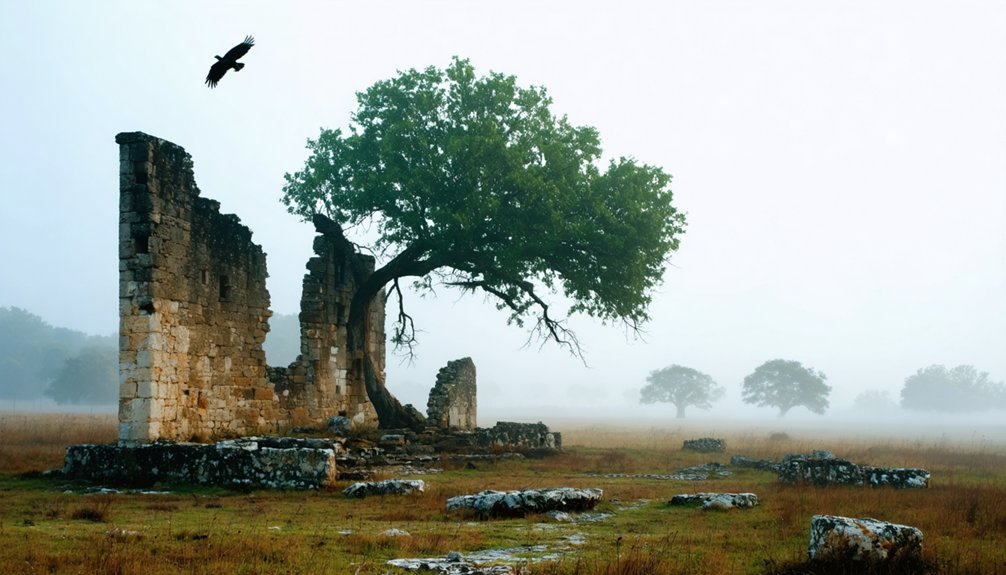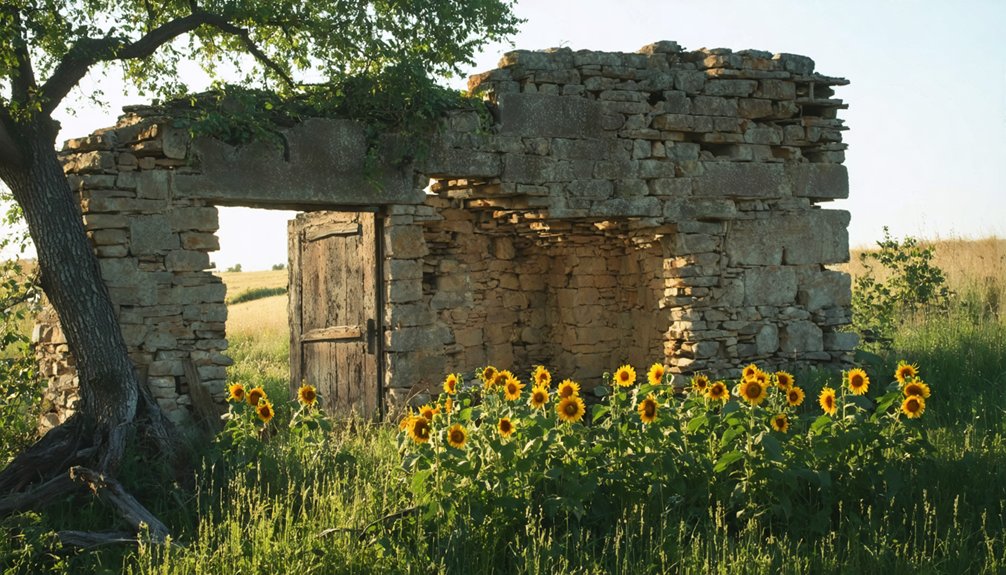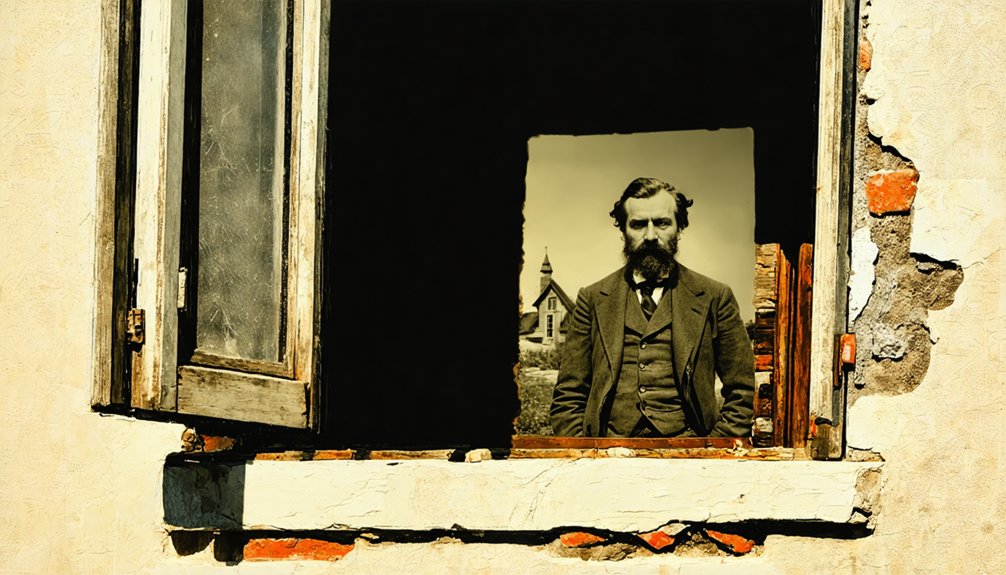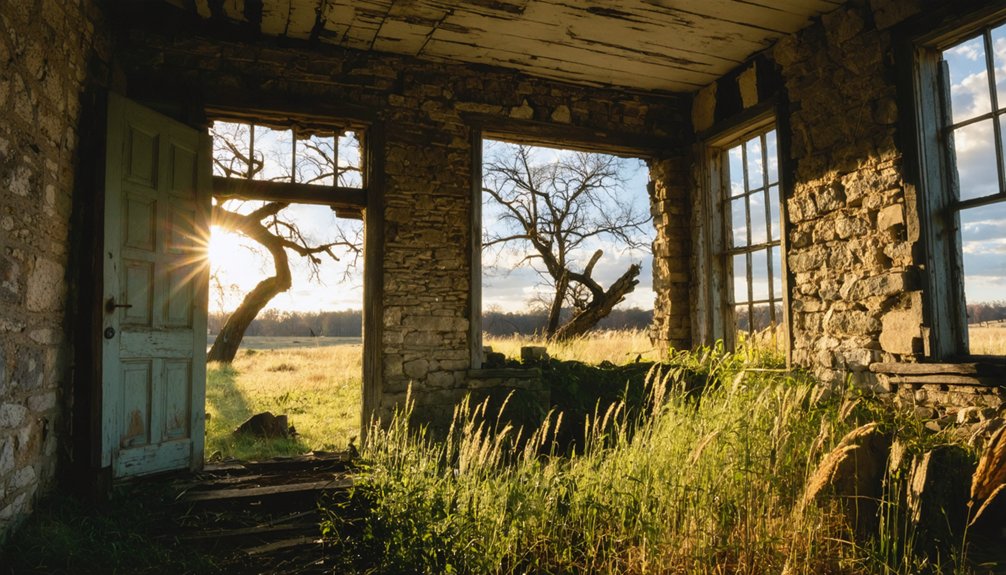You’ll find La Reunion’s ruins west of downtown Dallas, where European socialists attempted to create a utopian commune in 1855. Led by Victor Prosper Considérant, educated settlers from France, Switzerland, and Belgium established a democratic community with shared profits and communal living. Despite their idealistic vision, the colony collapsed within 18 months due to harsh weather, agricultural inexperience, and economic struggles. The remnants, including the Fish Trap Cemetery and DeLord homestead’s brick tower, hold fascinating stories of this ambitious experiment.
Key Takeaways
- La Reunion was a failed socialist commune established in 1855 near present-day Dallas, with only remnants of structures surviving today.
- The colony’s main physical remains include the DeLord homestead’s brick tower and front steps along Westmoreland Road.
- La Reunion Cemetery (Fish Trap Cemetery) contains weathered tombstones marking the final resting place of original European settlers.
- The settlement’s limestone ruins were later used in Dallas’s concrete production, integrating the ghost town’s materials into modern infrastructure.
- Urban development and wartime housing construction destroyed most of the original settlement’s structures and historical features.
The Vision of a Socialist Paradise
When Victor Prosper Considérant founded La Reunion in 1855, he envisioned creating a democratic socialist commune that would serve as a model for future settlements across the American Southwest.
His detailed plans, published in both French and English, outlined a revolutionary approach to communal living where profits would be shared based on each member’s capital and labor contributions.
You’ll find that Considérant’s socialist ideals attracted an educated group of Europeans, primarily from France, Switzerland, and Belgium.
The colony aimed to eliminate traditional hierarchical structures in favor of direct democracy and collective decision-making.
Following his exile to Belgium, Considérant saw Texas as an opportunity to establish his vision of a Fourier-inspired community.
The settlement was governed through a general assembly system, modeled after the democratic principles of ancient Athens.
European Settlers in Texas Territory
When you examine the European settlers’ arrival in Texas territory, you’ll find they faced intense cultural shock adapting from their familiar European lifestyles to the harsh realities of the American frontier.
You’d observe how these immigrants had to quickly adjust to unfamiliar agricultural methods, extreme weather conditions, and entirely different social structures from their homeland.
The settlers’ success often depended on their willingness to learn from experienced locals, including Mexican vaqueros and Native Americans, who understood the land’s unique challenges.
Spanish missionaries established numerous missions and presidios throughout the region to help newcomers adapt to frontier life.
These European immigrants joined a diverse wave of settlers that helped grow the population from 20,000 in 1830 to over 140,000 by the late 1840s.
Cultural Shock Upon Arrival
As European settlers arrived in La Reunion and the broader Texas territory, they encountered a stark reality that shattered their pre-conceived notions of life in the New World.
You would’ve faced immediate cultural adaptation challenges, from traversing a Spanish-speaking society to understanding unfamiliar Mexican legal systems. The religious conflicts were particularly jarring – as a Protestant settler, you’d have been required to convert to Catholicism and participate in Catholic rites to maintain your land grant. Trade was heavily regulated, as the Spanish colonial government imposed strict rules after lifting trade bans with Louisiana led to widespread smuggling.
Instead of the familiar European-style towns and governance you expected, you’d have encountered a complex hierarchy of presidios, missions, and Mexican officials. Local governance was maintained through elected alcaldes who handled administrative duties and settled disputes among settlers.
Even basic tasks like farming required completely new approaches, as European agricultural methods proved poorly suited to Texas’s distinctive climate and soil conditions.
Adapting To Frontier Life
Through the intricacies of Mexican colonization laws, European settlers in Texas territory faced a complex system of land acquisition that shaped their frontier adaptation.
You’d find yourself maneuvering a dual existence: pledging loyalty to Mexico while maintaining your cultural identity. Your survival strategies would include learning Spanish, participating in Catholic services, and adapting to the vaquero ranching traditions that dominated the region.
To secure your place, you’d need to master both farming and ranching skills, working smaller labors for crops while managing vast leagues for cattle. Under the leadership of Stephen F. Austin, settlers established thriving colonies along the Brazos and Colorado rivers.
Cultural integration meant embracing a lifestyle that blended European customs with Mexican and Native American influences. The Spanish conquistadors who arrived in 1519 had already established patterns of cultural exchange that would influence future settlements. You’d join a diverse community of Germans, French, and other Europeans, all adapting to the frontier’s demands while building new trade networks and social connections.
Daily Life in the Utopian Community
Life in La Reunion centered around a unique blend of cooperative labor and cultural refinement, guided by the settlement’s dual council system.
You’d find your daily routine shaped by communal meals in the shared kitchen and cooperative labor in the fields, where even educated businessmen adapted to farming duties.
In the evenings, you’d join fellow settlers for singing, dancing, and cultural events that attracted visitors from nearby Dallas.
While tending crops during the day, you might’ve supplemented your work by operating a small shop or practicing other trades.
The community’s white rock homes, though modest, supported the collective lifestyle.
Despite the challenges of frontier agriculture and food preservation, you’d experience a sophisticated social atmosphere where European traditions merged with Texas frontier life through music, dance, and cross-cultural relationships.
After a 72-day ocean voyage from France to Houston, settlers endured an equally long journey to reach their final destination.
The colonists included many skilled craftsmen and artisans who brought their European expertise to enhance the community’s cultural and economic life.
The Harsh Reality of Frontier Living
You’d find yourself battling brutal temperature swings at La Reunion, where drought conditions suddenly gave way to devastating blizzards that destroyed crops and threatened survival.
Your daily struggle for food would be compounded by poor soil conditions, late planting seasons, and a severe shortage of experienced farmers among the mostly intellectual settlers.
The constant threat of Comanche and Apache raids meant you couldn’t focus solely on farming and building – you’d need to maintain vigilant defenses while managing these challenges in an isolated frontier environment.
Hostile Weather Conditions
When the European settlers of La Reunion arrived in Texas during 1855, they couldn’t have imagined the brutal weather extremes that would ultimately contribute to their colony’s downfall.
You’d have witnessed colonists sleeping under umbrellas inside their homes as rain and snow penetrated through large cracks, while the Trinity River froze solid during the harsh winter of 1855-1856.
These weather challenges included meat freezing on one side while cooking on the other, highlighting the severe temperature fluctuations they faced.
The climate impacts proved devastating – droughts preceded blizzards, and the limestone terrain made farming nearly impossible.
Their poorly constructed shelters offered little protection from the relentless northers, leading to widespread illness among settlers and devastating losses of livestock.
Food Scarcity Challenges
Despite their professional talents in other fields, the European settlers of La Reunion found themselves woefully unprepared for the agricultural demands of frontier living.
You’ll find that their struggle with food shortages stemmed from a severe mismatch of skills, with only two farmers among a population of architects, writers, and craftsmen. Their survival strategies couldn’t overcome the harsh realities of Texas frontier life.
The colony’s food crisis was marked by:
- Insufficient agricultural expertise to cultivate crops in unfamiliar soil conditions
- Poor timing of settlement that missed vital planting seasons
- Limited success with European farming methods that failed to adapt to Texas terrain
As the population grew to 350 settlers, the demand for food outpaced their ability to produce it, forcing dependence on external supplies and contributing to the colony’s eventual abandonment.
Native American Conflicts
Beyond the daily struggles with food scarcity, La Reunion’s settlers faced an even more immediate threat to their survival: the ongoing Texas-Indian wars.
You’ll find that during the colony’s existence from 1855 to 1859, the frontier remained a dangerous battleground where conflict strategies between settlers and various tribal alliances shaped daily life.
While La Reunion’s European colonists focused on their socialist experiment, they weren’t prepared for the harsh realities of frontier defense.
The settlement existed during a period of intense warfare, with nearby settlers actively engaging in military actions against Comanche and other Plains tribes.
The colony’s peaceful ideals stood in stark contrast to the violent backdrop of broken treaties, retaliatory raids, and territorial disputes that characterized Texas frontier life.
Agricultural Struggles and Natural Disasters
As the settlers of La Reunion colony began their agricultural endeavors, they quickly discovered their French wooden plows were no match for the virgin chalky soil of Texas.
You’ll find their farming techniques evolved as they acquired large-beam prairie plows pulled by teams of horses and oxen, but this adaptation wasn’t enough to overcome their challenges.
Their agricultural struggles included:
The settlers faced constant agricultural hardships, from their urban backgrounds to unforgiving soil and devastating weather patterns.
- Most colonists lacked farming experience, coming from banking and business backgrounds
- The alkaline soil proved unsuitable for their intended crops
- Severe weather dealt devastating blows, including harsh winters and droughts
Crop failures mounted as nature seemed to conspire against them.
When grasshoppers destroyed their first harvest and drought wilted their wheat, the colony’s agricultural dreams began to crumble.
Only later did they discover the land’s true potential for peach orchards and vineyards.
Native American Relations and Security

While La Réunion’s settlers focused on their agricultural challenges, they found themselves operating within Texas’s complex frontier security environment of the 1850s.
You’ll find that decades of Native resistance had largely subsided by the time the colony was established, thanks to aggressive Texas policies that pushed tribes from their ancestral lands.
Yet frontier security remained a constant concern, as the colony’s position near the Trinity River attracted attention from both remaining indigenous groups and American frontiersmen.
Though direct conflicts had diminished due to disease and forced relocation of native populations, you’d still need to maintain vigilance against sporadic threats.
The settlers ultimately adapted by integrating into the broader American settlement system, with many colonists marrying locals and adopting the prevailing security practices of their neighbors.
The Dissolution of Communal Dreams
Despite their lofty socialist ideals and communal aspirations, La Réunion’s settlers found themselves ill-equipped for the harsh realities of frontier life.
The colony’s socioeconomic failures stemmed from a critical mismatch between its intellectual demographic and the practical demands of survival.
Idealistic thinkers found their abstract theories powerless against the concrete challenges of sustaining life on the frontier.
You’ll find these key factors led to the dissolution of their communal ideals:
- Urban professionals with minimal farming experience struggled to produce enough food.
- European agricultural methods proved ineffective in Texas’ challenging climate.
- The cooperative economic system faltered without traditional incentives.
While the settlers envisioned creating an equitable society through shared labor and resources, their lack of practical skills ultimately doomed the experiment.
The clash between utopian philosophy and frontier survival demands proved insurmountable, leading to the community’s eventual collapse.
Remnants and Ruins Today

Today you’ll find La Réunion’s weathered cemetery, enclosed by a chain-link fence in West Dallas, serving as the settlement’s most prominent physical monument and final resting place for colonists like Monsieur Reverchon.
The colony’s structural remains have largely vanished into urban decay, with only scattered foundation stones and rubble piles marking where buildings once stood amid the modern cityscape.
Historical photographs from the 1930s captured the Delord House ruins before the area transformed into Cement City, though now even these last visible traces have mostly disappeared beneath Dallas’s expanding metropolis.
Cemetery As Historic Monument
Among the few remaining traces of La Reunion’s utopian experiment, the La Reunion Cemetery stands as the most significant physical remnant of the 1850s French socialist colony near Dallas.
Today, you’ll find this historic monument struggling against time, with its cultural significance preserved through weathered tombstones and scattered ruins. The cemetery’s preservation faces ongoing challenges, yet it remains a powerful representation of the colonists’ dream of creating a cooperative society.
- Notable burials include botanist Julien Reverchon, the Santerre family, and Samuel Krause, connecting the site to broader Texas history.
- The 1974 historic marker recognizes the cemetery’s importance as a rare tangible link to the failed utopian experiment.
- While volunteers maintain the grounds sporadically, the site suffers from unclear maintenance responsibilities and urban encroachment.
Hidden Urban Decay
While modern Dallas sprawls around the former site of La Reunion, scattered brick remnants and crumbling foundations lie concealed within the urban landscape, offering silent testimony to the colony’s physical decline.
You’ll find these ruins hidden in plain sight, known only to urban exploration enthusiasts who venture through the redeveloping neighborhood.
Time and nature wage a constant battle against historical preservation, as weeds force their way through aging masonry and seasonal flooding erodes the surviving structures.
Industrial expansion, particularly cement production, has claimed portions of the original settlement, while modern development threatens what remains.
The ruins face mounting pressure from infrastructure projects, with many historic features already lost to quarrying activities or wartime housing construction of the 1940s.
Last Standing Structures
Despite decades of urban development surrounding the former La Reunion colony, only a handful of structural remnants survive to mark its existence.
You’ll find the most notable remains along Westmoreland Road, where the DeLord homestead‘s brick tower and front steps persist, though their exact location remains a local secret.
The site’s physical legacy is best preserved at the La Reunion Cemetery, also known as Fish Trap Cemetery.
- The cemetery’s weathered tombstones reveal the colony’s demographic makeup, including the grave of Samuel Krause, Bonnie Parker’s uncle.
- Roughly five structural remnants lie buried within dense vegetation throughout the area.
- Most ruins consist of unstable foundational remains, partial walls, and rubble piles hidden from public view.
Notable Residents and Their Stories

The utopian colony of La Reunion drew an eclectic mix of European intellectuals and artisans under the leadership of Victor Prosper Considérant, a wealthy French socialist and follower of Charles Fourier.
You’ll find that while the artisan community included shoemakers, philosophers, writers, and brewers, it particularly lacked experienced farmers – with only two self-identified agriculturalists among them.
Despite their socialist ideals, the colony’s skilled professionals struggled to adapt to frontier life.
While some left disillusioned, others stayed after the colony’s dissolution in 1857-1858, becoming integral to Dallas’s development.
Even Considérant relocated to San Antonio before returning to France.
The Henri and Reverchon families’ descendants maintain connections to La Reunion’s legacy, while the cemetery, where Bonnie Parker’s uncle was once buried, stands as a monument to their ambitious experiment.
Legacy in Dallas History
Many settlers who remained after La Reunion’s dissolution went on to shape Dallas’s physical and cultural landscape in lasting ways.
Though their socialist experiments didn’t survive, their immigrant contributions transformed the city’s development through industry, education, and culture. You’ll find their legacy preserved in modern Dallas landmarks and street names.
Despite the socialist colony’s collapse, La Reunion’s European settlers left an enduring mark on Dallas through their cultural and industrial innovations.
- The colony’s limestone ruins became integral to Dallas’s concrete production, literally building the growing city’s foundation.
- Notable colonists like Dr. Julien Reverchon and Benjamin Long became influential leaders in botany, education, and city government.
- Physical reminders include the Fish Trap Cemetery, a brick tower fragment, and prominent modern structures like Reunion Tower that honor the settlement’s memory.
Today, while the utopian dream faded, La Reunion’s impact on Dallas’s identity endures through its architectural, cultural, and historical footprint.
Frequently Asked Questions
Did Any Marriages Occur Between La Reunion Colonists and Local Texans?
While you can’t find definitive marriage records between colonists and locals, cultural exchange after the colony’s collapse suggests marriages likely occurred, though specific documentation hasn’t survived to confirm these unions.
What Languages Were Commonly Spoken in the La Reunion Colony?
With a million words flowing through the colony, you’d find French dominating daily life, while German and Swiss dialects added language diversity. English and local Spanish influence gradually emerged through interactions.
How Did the Colonists Celebrate Holidays and Maintain Their Cultural Traditions?
You’ll find the colonists maintained their European roots through holiday festivities, shared meals, religious ceremonies, music, dance, and storytelling. Their cultural practices emphasized communal gatherings despite challenging conditions.
What Type of Currency or Trade System Did La Reunion Use?
You’ll find no traditional currency exchange here – La Réunion used a fascinating communal system where profits and resources were shared based on your labor contribution and capital investment, bypassing any need for barter systems.
Were There Any Successful Businesses or Industries Within the Colony?
You’ll find the general store was the colony’s most successful enterprise, averaging $330 monthly in sales by 1857. Other industrial activities included blacksmith, mechanic, bootmaking, and tailoring shops with mixed results.
References
- http://texasghosttowns.blogspot.com/2011/11/la-reunion-dallas-county-august.html
- https://flashbackdallas.com/2016/03/26/la-reunion-utopia-on-the-trinity/
- https://blog.txfb-ins.com/texas-living/the-rise-and-fall-of-the-la-reunion-dallas-utopia/
- https://dallaspioneer.org/historical_articles/la-reunion-community/
- https://www.texasstandard.org/stories/how-a-failed-socialist-utopia-made-dallas-the-city-it-is-today/
- https://www.youtube.com/watch?v=gr0dy5JFvrE
- https://www.tshaonline.org/handbook/entries/la-reunion
- https://www.dmagazine.com/publications/d-ceo/2021/october/the-legacy-of-la-reunion-still-lives-on-in-dallas-today/
- http://exploredallashistory.com/saga-la-reunion-settlement-continues/
- https://oakcliff.advocatemag.com/2014/03/oak-cliff-history-how-the-la-reunion-colony-influenced-the-culture-of-our-neighborhood/



